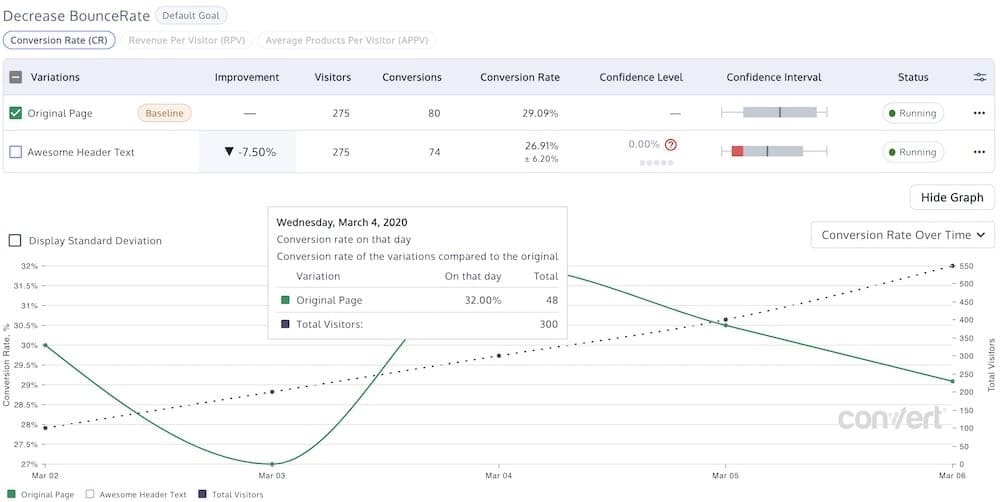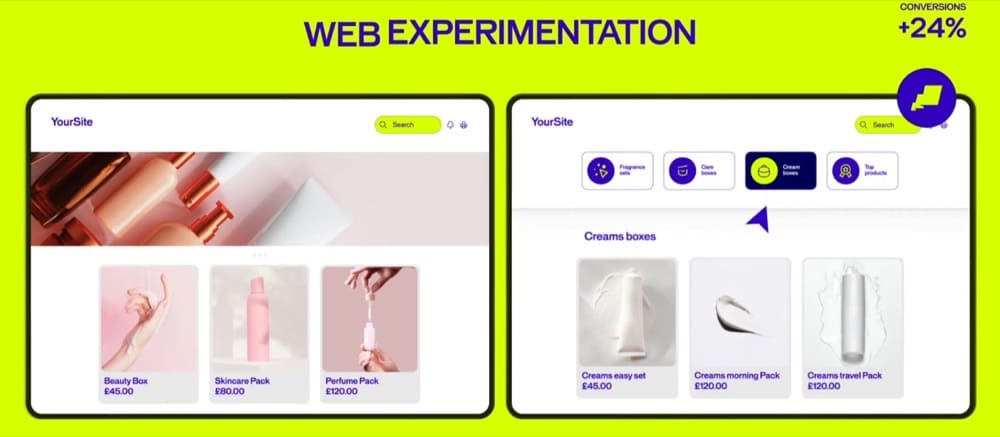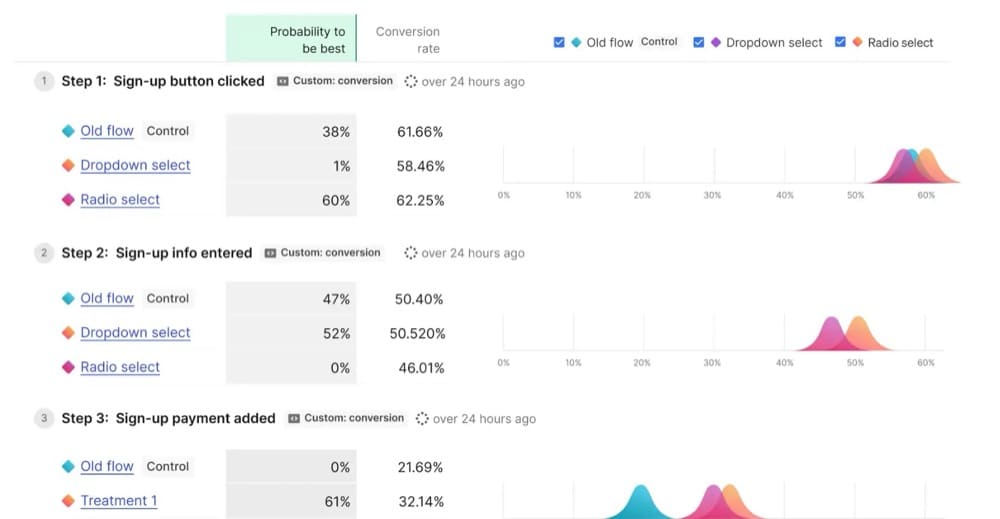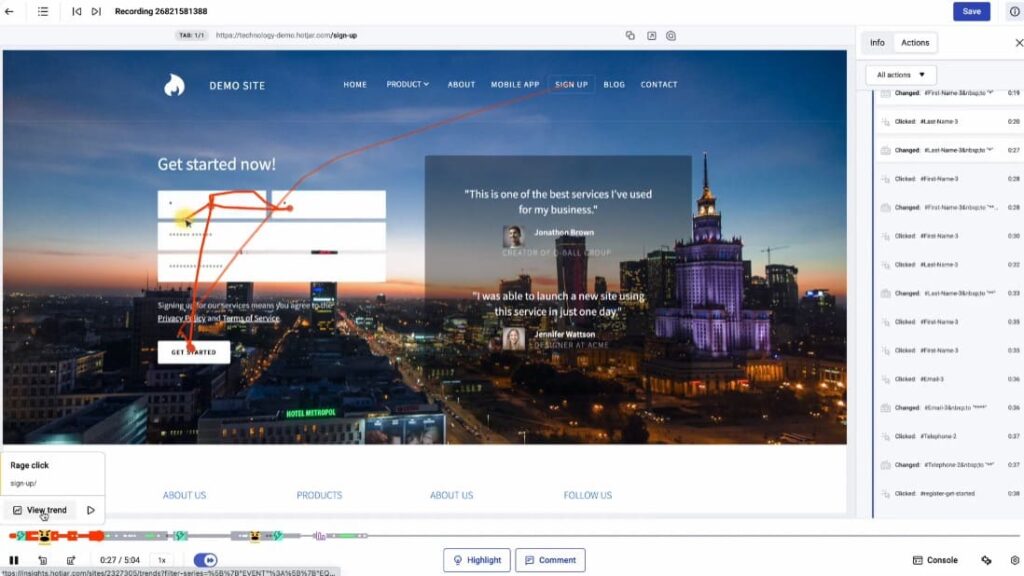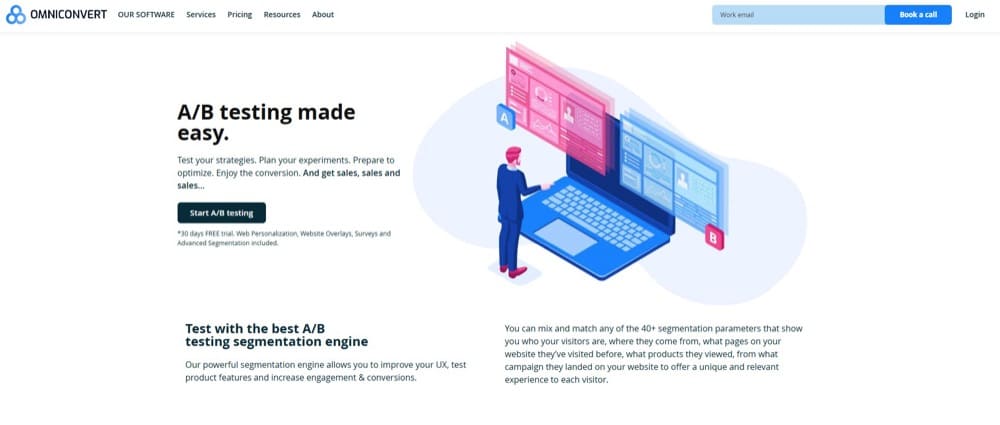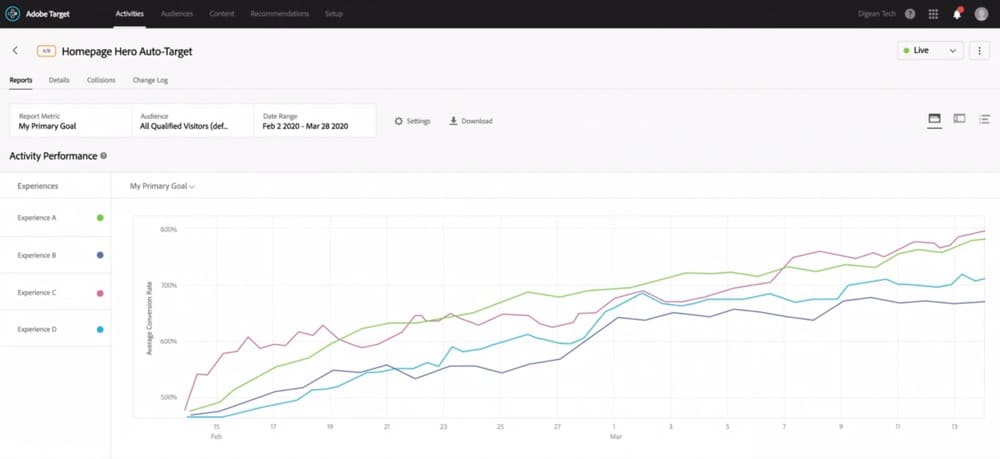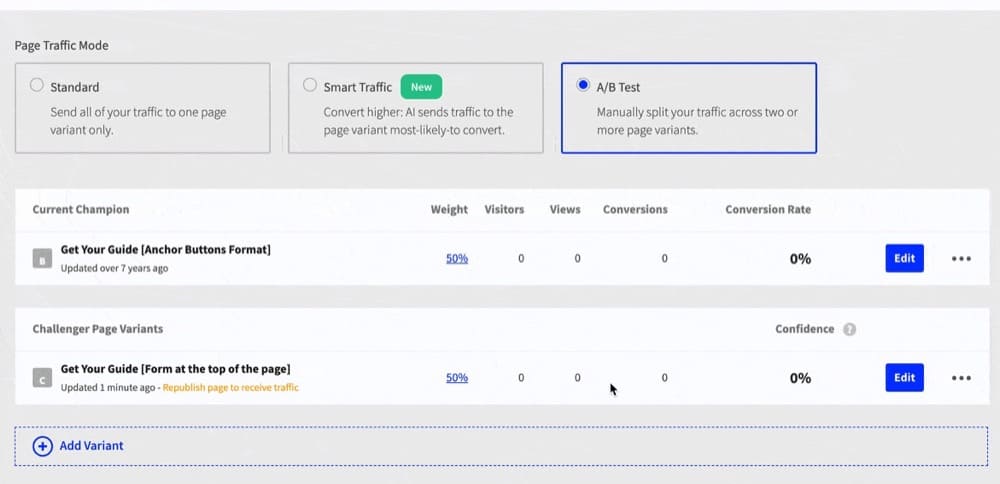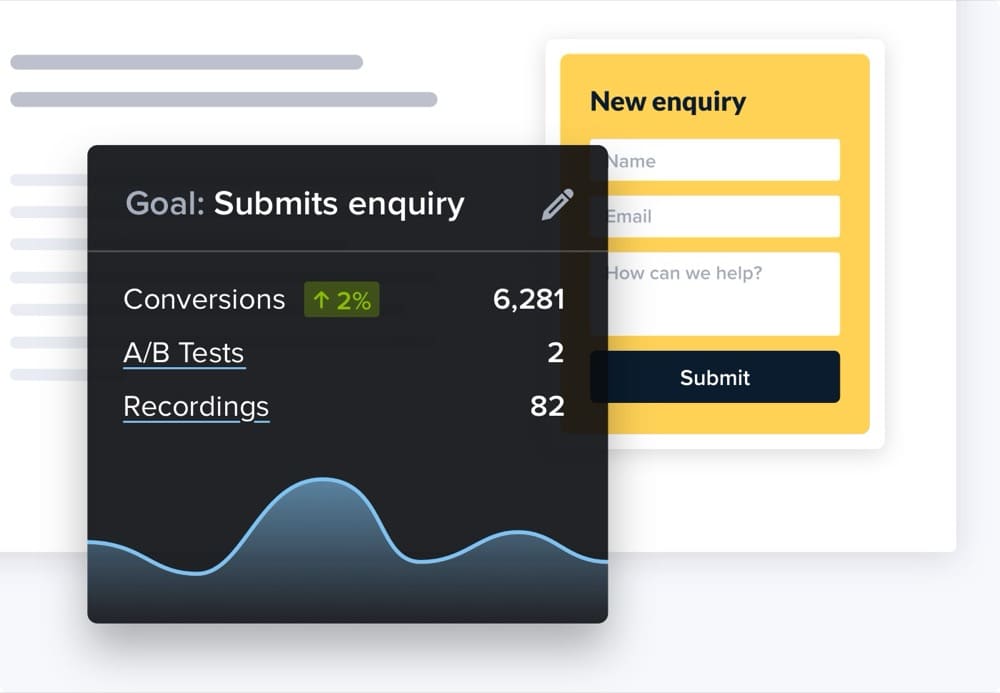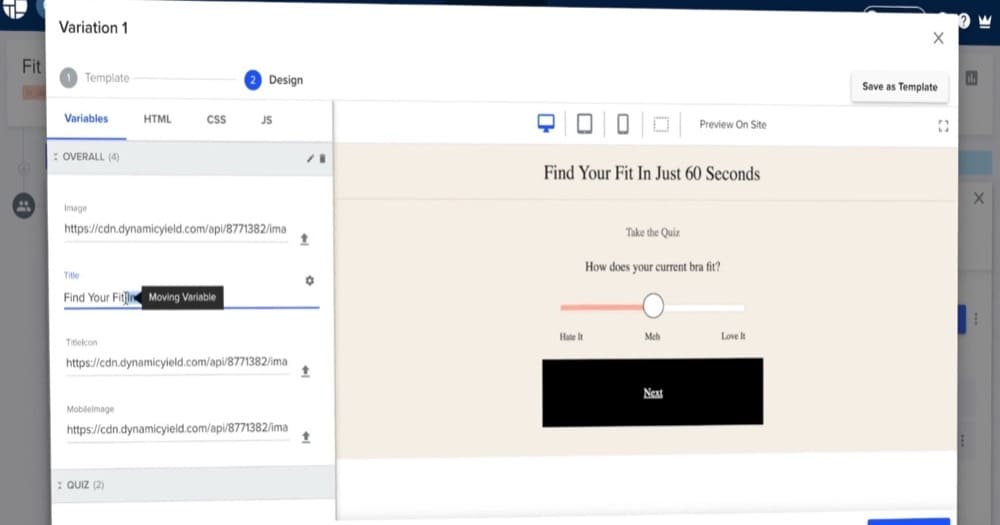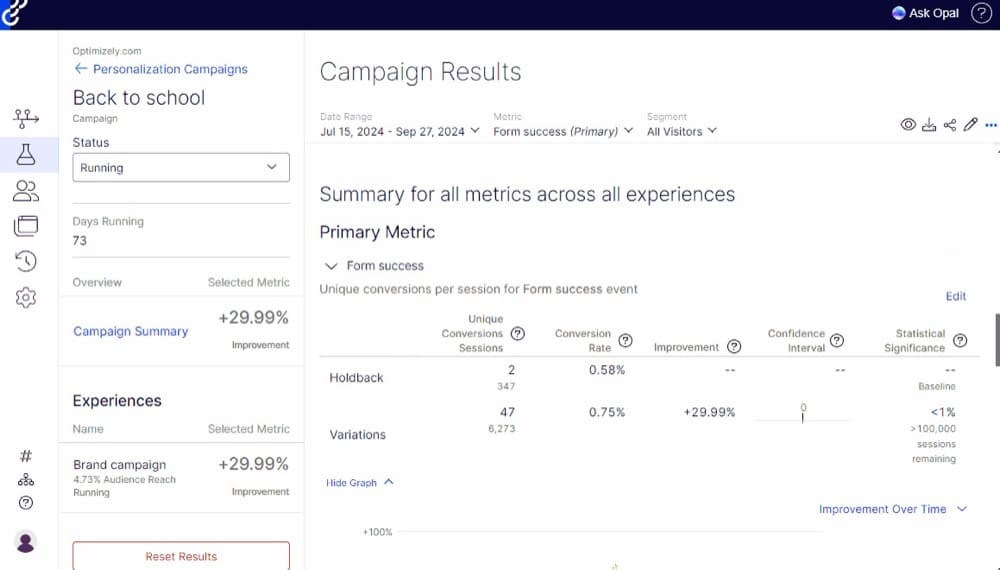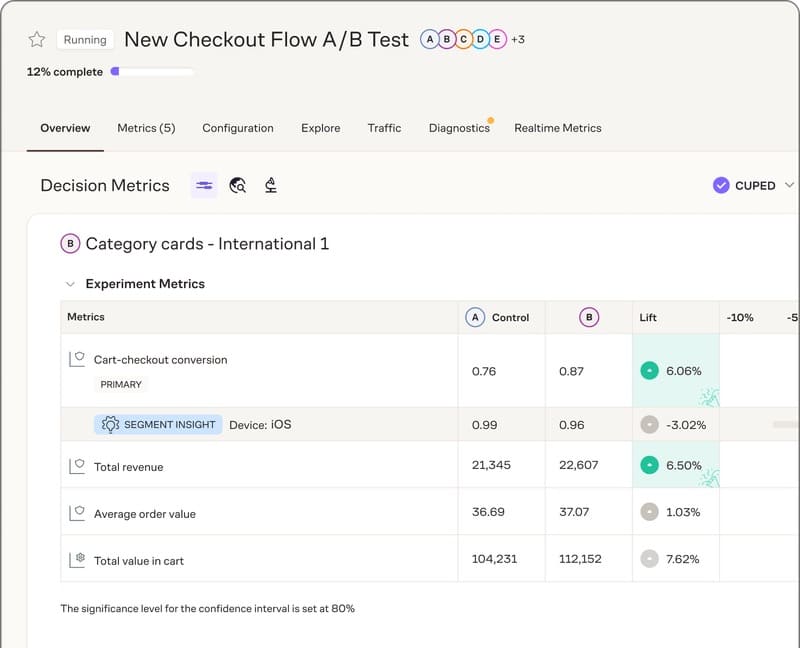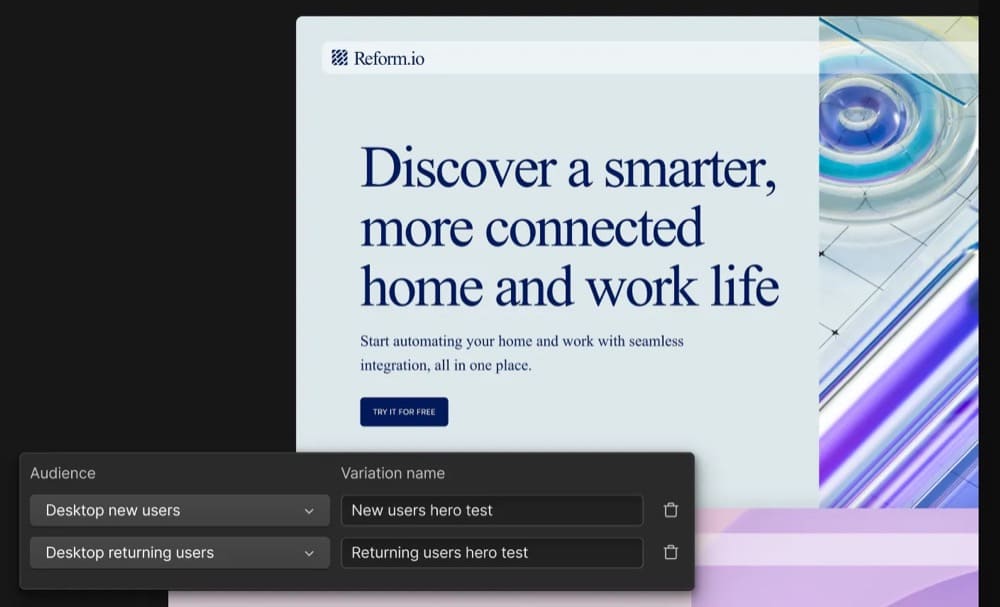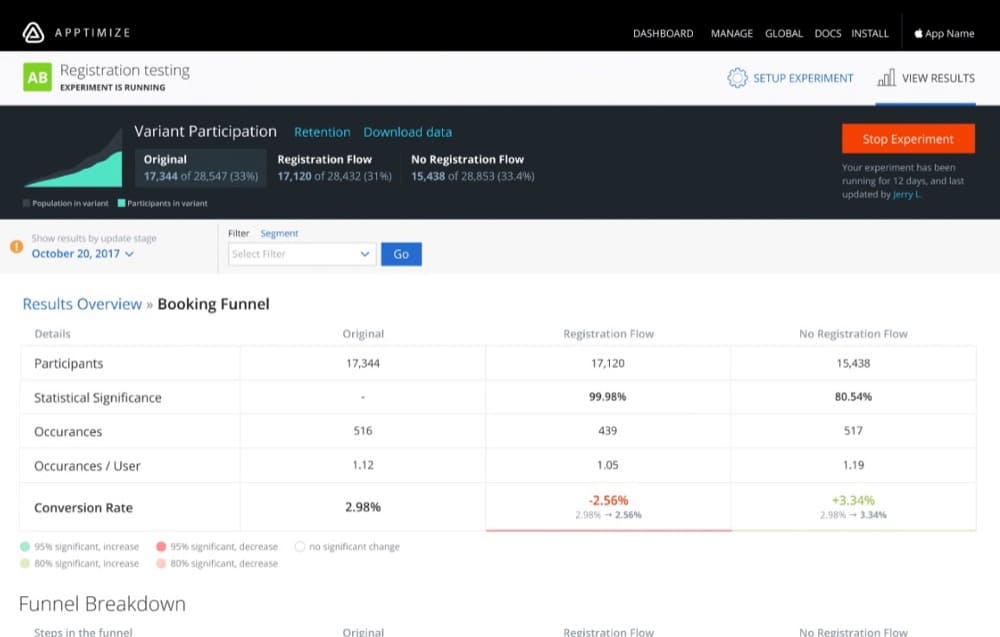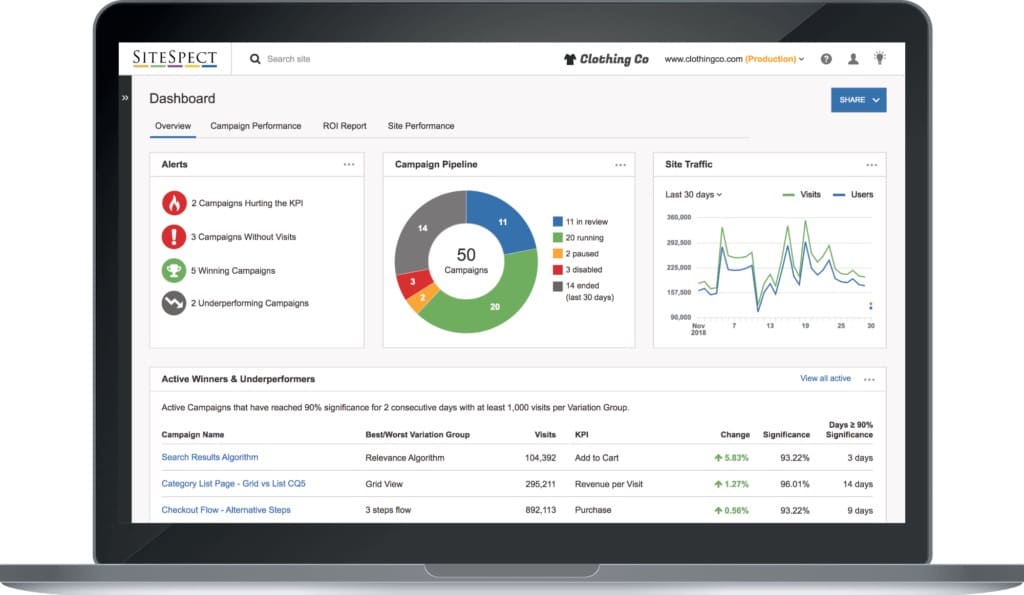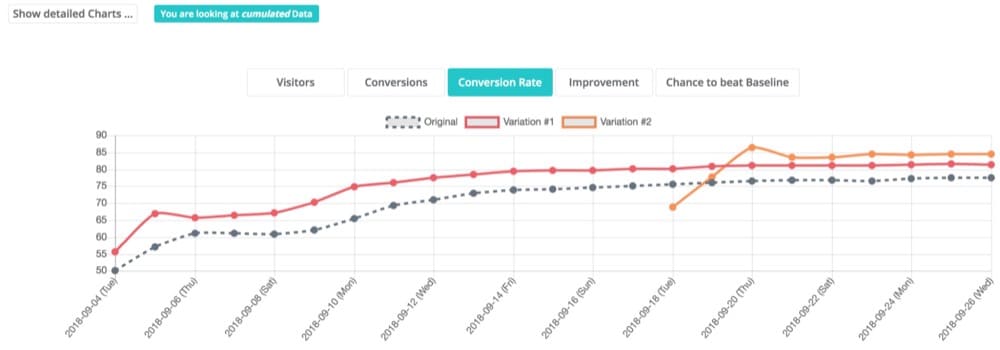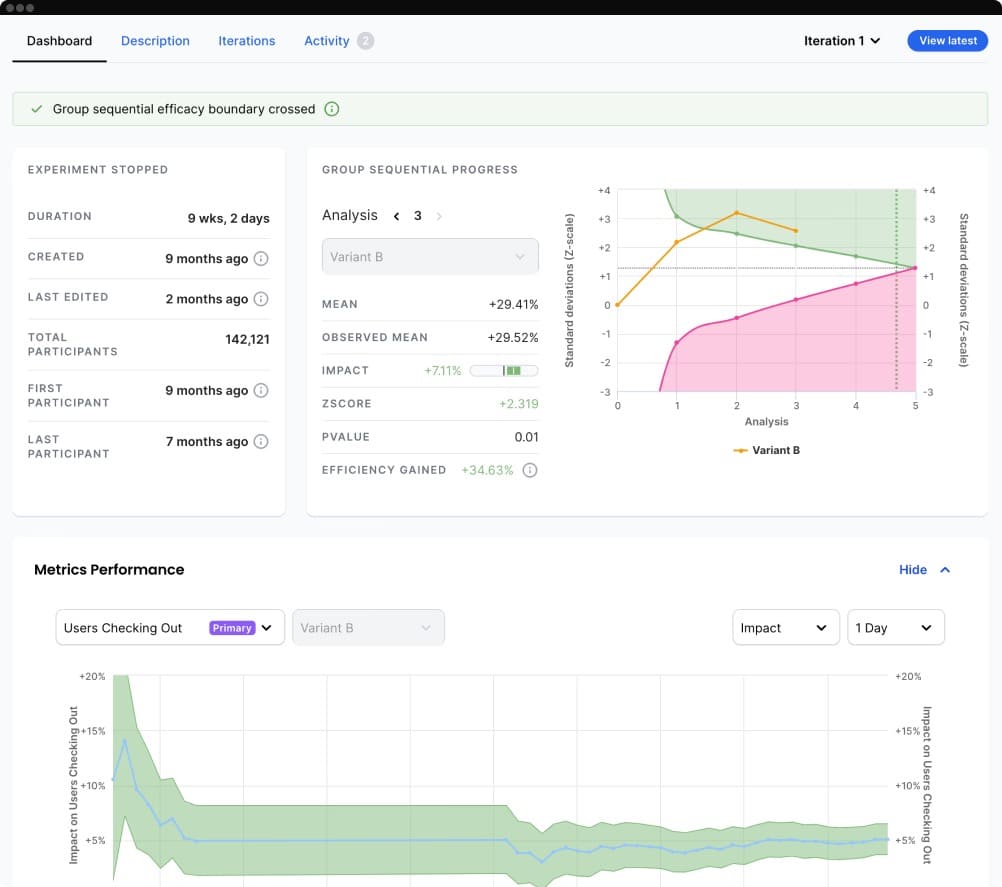20 Top A/B Testing Tools for Actionable Marketing Insights
A/B tests are the gold standard of evidence-based decision making for marketers, product managers, and all other business functions.
Finding a platform that can help you run controlled experiments, however, isn’t so straightforward. While there are many tools available, it can be confusing to find the right platform for your unique business and requirements.
In this piece, we will outline and review the top 20 A/B testing tools, tackling price and features, but also grouping and filtering them so you can find the best one for your needs.
Top A/B Testing Tools of 2025 Compared
| Product | Starting Price | Free Trial? |
Key Features | ||||||||||||||||||||
|---|---|---|---|---|---|---|---|---|---|---|---|---|---|---|---|---|---|---|---|---|---|---|---|
| Convert Experiences | $299/month | Yes, 15 days | Anti-flicker technology, full-stack experimentation capabilities, strong privacy and security |
||||||||||||||||||||
| AB Tasty | Contact sales | No | Advanced audience targeting, server-side feature management, enterprise-grade infrastructure |
||||||||||||||||||||
| LaunchDarkly | $120/year | Yes, 14 days and free Developer plan | Feature flags, multivariate experiments, advanced audience targeting, reusable metric groups |
||||||||||||||||||||
| Hotjar | $49/month | No, but offers a free plan | Behavior heatmaps, session recordings, integrated feedback collection |
||||||||||||||||||||
| VWO | $220/month | Yes, 30 days and free Starter plan | Visual editor, A/B and multivariate testing, multiple integrations |
||||||||||||||||||||
| Omniconvert | $273/month | Yes, 30 days | No-code A/B test builder, advanced segmentation, real-time reporting |
||||||||||||||||||||
| Adobe Target | Contact sales | No | A/B and multivariate testing, AI-powered recommendations, omnichannel personalization |
||||||||||||||||||||
| Unbounce | $112/month | Yes, 14 days | No-code A/B testing, unlimited page variants, AI-powered traffic routing |
||||||||||||||||||||
| Crazy Egg | $99/month | Yes, 30 days | Visual editor, session recordings, heatmaps, unlimited A/B tests |
||||||||||||||||||||
| Kameleoon | Contact sales | No | Visual and code editors, robust security and compliance, proprietary testing and data accuracy technology |
||||||||||||||||||||
| Dynamic Yield | Contact sales | No | Experience OS personalization tools, visual editor, full campaign optimization |
||||||||||||||||||||
| Optimizely | Contact sales | No | Visual editor, unlimited experiments, native or integrated analytics, CMS |
||||||||||||||||||||
| Eppo | Contact sales | No | A/B and multi-armed bandit testing, secure warehouse native platform, feature flagging |
||||||||||||||||||||
| Webflow Optimize (formerly Intellimize) | $299/month | No | Automated A/B testing, machine learning, dynamic content optimization |
||||||||||||||||||||
| Apptimize | Contact sales | No, but offers a free Feature Flags plan | Multi-variable testing, AI optimizations, cross-platform experiments |
||||||||||||||||||||
| SiteSpect | Contact sales | No | A/B and multivariate testing, visual editor, server-side experiment delivery, deep segmentation |
||||||||||||||||||||
| Zoho PageSense | $12/month | Yes, 15 days | A/B and split URL testing, comprehensive conversion tracking, visual editor |
||||||||||||||||||||
| Amplitude | $49/month | No, but offers a free Starter plan | A/B testing, real-time tracking, session replay, native product analytics, custom audiences |
||||||||||||||||||||
| ABlyft | Contact sales | No, but offers a free plan | Privacy compliance, fast performance, visual editor, flexible customization |
||||||||||||||||||||
| ABsmartly | €60,000/year (approx. $61,529/year) | No | Unlimited experimentation, robust data analysis, user and device-level experiments |
20 Best A/B Testing Tools in 2025
- Convert Experiences
- AB Tasty
- Launch Darkly
- Hotjar
- VWO
- Omniconvert
- Adobe Target
- Unbounce
- Crazy Egg
- Kameleeon
- Dynamic Yield
- Optimizely
- Eppo
- Webflow Optimize (formerly Intellimize)
- Apptimize
- SiteSpect
- Zoho PageSense
- Amplitude
- ABlyft
- ABsmartly
1. Convert Experiences
Best For: Mid-market companies scaling experimentation
Convert delivers scalable, enterprise-grade A/B testing capabilities without the enterprise price tag. You can run both frontend and backend experiments with zero flickering using its SmartInsert technology, while the platform’s 40+ stackable targeting filters and API enable sophisticated test deployment.
Convert’s comprehensive toolkit includes real-time QA through Live Logs & QA Wizard, built-in hypothesis prioritization frameworks, and automated collision prevention—all backed by expert support to help you launch tests in under 30 minutes.
Key Features:
- Advanced anti-flicker technology: Ensures your A/B tests load quickly and seamlessly without any visual disruptions that could impact user experience or test results.
- Full-stack experimentation capabilities: Supports both client-side and server-side testing, allowing teams to run experiments anywhere in their tech stack while managing feature flags and rollouts.
- Advanced audience targeting: Enables precise visitor segmentation based on location, behavior, devices, and custom JavaScript conditions for more accurate test results.
- Enterprise-grade privacy and security: Ensures secure and compliant testing operations while protecting visitor data with built-in privacy compliance notifications, SSO integration, and two-factor authentication.
Pros:
- Convert offers a robust code editor for CSS and JavaScript that allows for complete control over implementation.
- Real-time reporting with interactive graphs helps optimization specialists make data-driven decisions faster and visualize experiment results.
- The ability to switch between Frequentist and Bayesian statistics engines adds flexibility in how you analyze experiment results.
- Integrations with multiple tools, including Shopify, Hotjar, WordPress, and HubSpot.
Cons:
- The absence of multivariate testing capabilities in the entry-level plan restricts the types of complex experiments you can run without upgrading.
Pricing: Offers a 15-day free trial; plans start at $299 a month for up to 100,000 tested users.
2. AB Tasty
Best For: Enterprise ecommerce teams scaling cross-channel experimentation programs
AB Tasty helps drive revenue through comprehensive experimentation and personalization capabilities. You can run A/B tests across web, mobile, and product features while using AI-powered tools to create personalized experiences. The platform combines robust testing capabilities with intuitive experience building, content personalization, site search, and feature flags and rollbacks. They go beyond the website experience, as well, with email-based product and content recommendations.
Key Features:
- Advanced audience targeting: Provides sophisticated audience building capabilities that combine behavioral data, location, interests, and third-party segments from CDPs and analytics tools for precise test targeting.
- Server-side feature management: Allows technical and non-technical teams to deploy and test features using a visual interface, with automatic rollback capabilities based on KPI thresholds for risk mitigation.
- Enterprise-grade performance infrastructure: Delivers high-performance experimentation through a global CDN with 200+ points of presence, supporting petabytes of events and ensuring minimal impact on page load times.
Pros:
- The platform offers both client-side and server-side experimentation capabilities for increased flexibility while running tests across multiple channels.
- The EmotionsAI module offers a novel way to segment and personalize experiences for users, leveraging AI to analyze and segment your visitors into an emotional profile for emotional personalization.
- The extensive analytics suite provides revenue per user attribution by campaign and time period, demonstrating clearer ROI.
Cons:
- The JavaScript-dependent architecture may limit testing capabilities on certain pages or elements.
- The tag implementation requires careful performance optimization to maintain Core Web Vitals scores, which could create additional work for teams focused on speed metrics.
Pricing: Contact AB Tasty for a demo.
3. LaunchDarkly
Best For: Product managers and developers testing and monitoring software releases
Run sophisticated A/B tests and experiments directly within your feature management workflow with LaunchDarkly. You can rapidly test multiple variations, track conversion metrics, and optimize both frontend and backend features—all without complex deployments or code changes. The platform removes traditional experimentation barriers through built-in statistical analysis, flexible audience targeting, and seamless integration with your existing analytics stack.
Product managers can manage software releases through feature flags and guarded releases, ensuring a consistent and smooth user experience.
Key Features:
- Multivariate testing and experimentation: Launch multiple feature variations simultaneously through A/B/n testing capabilities.
- Advanced audience targeting: Define precise experiment cohorts using contextual rules based on user attributes, devices, location and custom segments.
- Metric groups and funnel analysis: Create reusable groups of conversion metrics and track entire conversion funnels, providing comprehensive insights into how feature changes impact user behavior throughout the customer journey.
- Feature flags and guarded releases: Launch and monitor product features and releases through controlled deployments, offering real-time control and context-aware targeting.
Pros:
- LaunchDarkly unifies feature management and A/B testing in a single platform, enabling product and CRO teams to launch experiments faster.
- The platform supports sophisticated funnel experiments across any software type: mobile apps, websites, or server-side changes.
- Real-time monitoring and event tracking automatically measures the impact of feature changes on user behavior.
Cons:
- The platform requires technical implementation and developer involvement for setup.
- LaunchDarkly’s feature flag approach to testing requires more careful planning and coordination between development and product teams compared to traditional visual testing tools.
Pricing: Offers a 14-day free trial and a free forever Developer plan with feature flagging and experimentation. Paid plans start at $120 per year.
4. Hotjar
Best For: Marketers and PMs gathering qualitative data and identifying UX friction points
Hotjar combines powerful behavior analytics and qualitative feedback tools to help you identify UX bottlenecks and inform experiment hypotheses with confidence. Watch recordings of real user sessions and view heatmaps to identify friction points while collecting direct feedback through surveys to understand the “why” behind user actions.
Key Features:
- Behavior heatmaps: Visual representations of user interactions show exactly where visitors click, move, and scroll, helping you identify which page elements drive engagement and which are ignored.
- Session recordings: Watch real visitors navigate your site to uncover unexpected friction points, bugs, and conversion blockers that quantitative data alone might miss.
- Integrated feedback collection: Combine quantitative behavior data with qualitative user feedback through surveys and feedback widgets to understand not just what users do, but why they do it.
Pros:
- Hotjar’s integrated heatmaps and session recordings provide immediate visual insights into user behavior patterns, enabling you to quickly identify optimization opportunities.
- The dedicated funnel visualization tool helps A/B testers track conversion paths and identify drop-off points.
- Direct integration with multiple A/B testing platforms and Google Analytics allows testing experts to correlate behavioral data with test results.
Cons:
- The lack of a built-in A/B testing tool requires users to rely on third-party integrations, potentially complicating the testing workflow and increasing costs.
- Pricing goes up based on usage, such as monthly survey responses or recorded sessions, which may restrict the depth of qualitative research.
Pricing: Offers a free plan with up to 20,000 monthly sessions; paid plans start at $49 per month when paid annually.
5. VWO
Best For: High-traffic ecommerce brands scaling global experimentation
VWO enables comprehensive experimentation across your entire tech stack—from front-end to back-end systems. You can deploy A/B tests, multivariate tests, and feature rollouts using lightweight SDKs while leveraging AI-powered insights through VWO Copilot. The platform combines robust testing capabilities with behavioral analytics—including heatmaps, session recordings, and funnel analysis—to drive data-informed decisions.
Key Features:
- Visual editor with AI integration: A comprehensive point-and-click editor that enables easy creation of test variations with AI-powered copy suggestions.
- SmartStats with Bayesian statistics: A statistical engine that provides real-time Bayesian analysis with customizable filters and KPI guardrails protection.
- Seamless integration ecosystem: Easy integration with various analytics, CDP, ecommerce, and marketing tools, plus CMS plugins and real-time data sync capabilities for comprehensive data analysis.
Pros:
- The intuitive drag-and-drop interface enables CRO experts to quickly set up and launch A/B tests without requiring extensive technical knowledge.
- The end-to-end platform integrates testing, personalization, and insights in one interface.
- The heatmaps and clickmaps features enable data-driven decision-making.
Cons:
- The monthly tracked users (MTU) cap restricts testing capabilities unless you pay more.
- The platform’s advanced personalization features have scaling limitations, making it challenging to implement sophisticated personalization campaigns.
Pricing: Offers a 30-day free trial and a free Starter plan with limited features. Paid plans start at $220 per month when paid annually.
Not sure VWO is right for you? One of these VWO alternatives might be a better fit.
6. Omniconvert
Best For: Mid-market ecommerce testing managers seeking comprehensive customer insights
Omniconvert enables you to run unlimited A/B tests, create personalized experiences, and capture valuable user insights. You can quickly implement tests using intuitive editors and ready-to-use templates, while 40+ advanced segmentation criteria let you target specific user groups with precision.
The platform includes comprehensive features like heatmaps, user recordings, and survey tools to help you make data-driven optimization decisions. Omniconvert divides its product suite into three distinct portions, each helping tackle one portion of customer lifetime value optimization:
- Omniconvert Explore: CRO platform and functionalities to run controlled experiments (A/B and multivariate) and run personalization campaigns.
- Omniconvert Reveal: Customer analytics features to derive both qualitative and quantitative insights on user behavior.
- Omniconvert Pulse: Customer experience features to action on UX insights, analyze and segment NPS scores, and deliver great customer support through helpdesk triggers and customer communications.
Key Features:
- Advanced A/B testing engine: Omniconvert combines both visual and code-based editors with the ability to run split URL tests and device-specific experiments.
- Dual statistical analysis framework: A robust statistical engine offering both Bayesian and Frequentist models with automatic significance calculation at 95% threshold, providing reliable data-driven insights for decision making.
- Dynamic web personalization: The content adaptation system delivers personalized experiences based on user behavior, location, device type, and weather conditions, enhancing user engagement and conversion potential.
Pros:
- The platform combines A/B testing with advanced segmentation capabilities, enabling CRO experts to run highly targeted experiments for specific user groups.
- Omniconvert offers both visual and code editors, allowing teams to run simple tests quickly while maintaining the flexibility for complex front-end modifications.
- The comprehensive analytics suite tracks up to 30 goals per experiment with revenue metrics.
Cons:
- The visual editor is limited to basic element modifications.
Pricing: Offers a 30-day free trial; paid plans start at $273 per month when paid annually.
7. Adobe Target
Best For: Enterprise optimization teams scaling cross-channel experimentation with AI
Adobe Target helps you optimize experiences through AI-powered A/B testing, multivariate testing, and personalization capabilities that work across all channels. You can automate and scale your optimization efforts using AI-driven insights while maintaining unified customer profiles for consistent experiences.
Key Features:
- A/B and multivariate testing: Adobe Target enables rigorous testing of multiple variations across web, mobile apps, and IoT devices on both client and server sides.
- AI-powered automated personalization: The platform leverages advanced machine learning algorithms to automatically match different content variations to specific users, optimizing conversion rates through real-time personalization.
- Real-time analytics integration: Direct connectivity with Adobe Experience Platform and Customer Journey Analytics provides comprehensive testing performance analysis and unified customer profiles for more informed optimization decisions.
Pros:
- Adobe Target’s AI-powered automation enables rapid testing and optimization at scale with less manual effort.
- The platform’s comprehensive omnichannel personalization capabilities help create consistent experiences across all customer touchpoints.
- Real-time integration with Adobe Experience Platform provides advanced analytics and reporting.
Cons:
- The platform has a steep learning curve with complex features.
- The interface can be slow and occasionally struggles with large-scale testing.
Pricing: Contact Adobe for a demo.
8. Unbounce
Best For: Non-technical marketers building and testing landing pages without coding
With Unbounce, you can build landing pages and run A/B tests without too much technical expertise or developer support. Instantly create page variants, conduct simply split tests, and analyze test results—all from a single platform.
Key Features:
- AI-powered Smart Traffic: Automatically routes visitors to the landing page variant where they’re most likely to convert—or manually split traffic however you like.
- No-code A/B testing: Create and launch A/B tests without requiring designers or developers.
- Actionable data insights Identify the winning version of your landing page with real-time reporting, or dive into AI-generated conversion pattern insights and opportunities.
Pros:
- No-code A/B testing tools enable CRO experts to quickly build and launch test variants without developer support.
- Smart Traffic’s AI-powered optimization automatically directs visitors to their highest-converting page variants—saving time on manual test management.
- The platform provides real-time analytics with confidence intervals.
Cons:
- The platform only allows A/B testing of pages built within Unbounce.
- Traffic limits on subscription plans can restrict testing velocity and scalability.
Pricing: Offers a 14-day free trial; paid plans with A/B testing features start at $112 per month when paid annually.
9. Crazy Egg
Best For: Ecommerce teams optimizing product page conversions
Crazy Egg’s comprehensive toolkit includes heatmaps, session recordings, and A/B testing. Pinpoint exactly where visitors engage, struggle, or abandon your site through detailed heatmaps and recordings, while built-in A/B testing capabilities let you validate improvements and measure their impact on conversions.
Key Features:
- Easily identify friction points: Provides detailed visualization of visitor behavior through color-coded heatmaps, scroll mapping, and recorded user sessions that show exactly where users click, scroll, and focus their attention on your website.
- Code-free A/B testing: Offers a visual editor for creating and running tests, with automatic traffic allocation to winning variants.
- Detailed conversion analysis: Segments conversions into traditional traffic metrics along with unique events such as when a visitor clicks a certain element, lands on a certain page, submits a form, or triggers an ad conversion pixel or custom script.
Pros:
- The integrated A/B testing functionality allows direct implementation of optimization hypotheses.
- An intuitive interface helps you analyze user engagement without a steep learning curve.
Cons:
- The heat mapping feature offers limited visualization options.
- Crazy Egg provides fewer advanced analytics features compared to competitors.
Pricing: Offers a 30-day free trial; paid plans start at $99 per month when paid annually.
10. Kameleoon
Best For: An enterprise-level full-stack platform
Kameleoon’s experimentation platform helps you accelerate growth through A/B testing, AI-driven personalization, and feature management. You can leverage the platform’s AI Copilot to streamline test creation, while benefiting from real-time results powered by advanced statistical engines and data accuracy safeguards like its CUPED methodology.
Key Features:
- Visual editor with code capabilities: Combines a no-code visual editor for marketers with a full-featured JavaScript/CSS code editor for developers, enabling both technical and non-technical teams to create sophisticated experiments.
- Enterprise-grade security and compliance: Includes HIPAA, GDPR, and CCPA compliance, along with SSO login support and private cloud deployment options.
- Flicker-free technology: Eliminates the flash of original content (FOOC) during A/B tests with proprietary technology, providing a seamless user experience while maintaining fast page load times.
Pros:
- The platform provides unlimited testing capabilities across variations, traffic, targeting, and KPIs.
- Integration with 20+ analytics platforms enables teams to leverage existing data infrastructure and maintain consistent measurement across experimentation programs.
Cons:
- Advanced features may require a steeper learning curve for non-technical users.
Pricing: Contact Kameleeon for a demo and pricing information.
11. Dynamic Yield
Best For: AI-powered ecommerce product recommendations at scale
Dynamic Yield’s Experience OS helps you run many different types of experiments while delivering AI-powered personalization across all digital touchpoints. Quickly launch experiments anywhere on your digital properties, analyze audience behavior, and automatically optimize content, product recommendations, and offers based on real-time data. The platform combines solid testing capabilities with machine learning to predict customer interests and automate personalization decisions.
Key Features:
- Multi-armed bandit testing: The platform’s dynamic traffic allocation system automatically routes more visitors to winning variations during A/B tests, maximizing conversion opportunities while experiments are still running.
- Visual experience editor: A point-and-click interface enables marketers to create and deploy A/B tests and personalized experiences across any digital touchpoint without requiring developer resources.
- Multi-touch campaign optimization: The platform allows testing and optimization across entire customer journeys, not just individual pages, helping teams understand and improve the full conversion funnel.
Pros:
- Advanced A/B and multivariate testing capabilities offer deep user-level and product-level personalization options.
- The intuitive interface allows non-technical teams to easily set up and run personalized campaigns.
Cons:
- A/B test implementation requires custom code integration even with client-side deployment, which may slow down test velocity for CRO teams.
- Built-in analytics capabilities are limited, potentially requiring CRO experts to rely on additional tools for deeper analysis.
Pricing: Contact Dynamic Yield for a demo and pricing information.
12. Optimizely
Best For: Scaling enterprise experimentation programs across multiple domains
A comprehensive experimentation and content management platform, Optimizely comes with an intuitive, low-code visual editor that lets you rapidly deploy A/B tests, multivariate tests, and multi-page experiments. The platform’s advanced features include AI-powered content suggestions, a sophisticated Stats Accelerator for rapid, reliable results, and audience targeting capabilities.
Key Features:
- Unlimited concurrent experiments: Supports running multiple simultaneous experiments across different pages and user segments, with built-in mutual exclusivity options to prevent experiment interference.
- Comprehensive analytics: Gather faster experiment insights with the proprietary Stats Engine—or integrate with 65+ third-party analytics platforms for full visibility into experiment performance.
- CMS functionality: Optimizely One offers a unified web platform to host and manage content, run experiments, manage digital assets, and enable digital commerce.
Pros:
- Includes collaboration and project management tools to manage experiments from idea to winning solution.
- Built-in multivariate testing capabilities allow optimization experts to test multiple variables simultaneously.
- The visual editor enables quick implementation of A/B tests without requiring extensive coding knowledge, letting CRO specialists launch tests faster.
Cons:
- The platform experiences performance slowdowns when handling complex experiments or high traffic volumes, which can impact test reliability.
- Optimizely’s advanced features and statistical tools require a steep learning curve.
- The pricing structure is relatively expensive compared to competitors.
Pricing: Contact Optimizely for pricing information.
13. Eppo
Best For: Warehouse-native A/B testing with statistical rigor
A warehouse-native A/B testing platform, Eppo eliminates analysis cycles while maintaining statistical rigor. You can increase experiment velocity and reduce test duration with CUPED++ acceleration, all while keeping your data secure in your warehouse. Eppo’s robust feature management and automated analysis capabilities help you make faster, more confident decisions through trusted statistical methods and comprehensive metric tracking.
Key Features:
- Advanced statistical engine: Eppo’s statistical framework combines sequential testing, CUPED++ variance reduction, and Bayesian methods to deliver faster experiment results while maintaining statistical rigor and reducing false positives.
- Automated experiment analysis: The platform automates the entire experimentation analysis cycle, providing instant metric calculations and automated deep dives while maintaining statistical rigor for trustworthy results.
- Feature flag management: Built-in feature flagging capabilities enable seamless deployment control and remote configuration, making it easy to roll out experiments and manage feature releases across your application.
Pros:
- The warehouse-native architecture eliminates data privacy concerns and reduces costs by keeping all experimentation data within your existing infrastructure.
- The platform’s advanced statistical methods significantly reduce experiment runtime for faster decision-making.
Cons:
- The platform requires an existing data warehouse setup (Snowflake, Databricks, BigQuery, or Redshift), which may limit options for companies using alternative data solutions.
- Teams must invest time in setting up and maintaining their metric definitions and experiment configurations within their data warehouse environment.
- The learning curve may be steeper for non-technical team members who need to understand warehouse-native concepts for effective platform usage.
Pricing: Contact Eppo for a demo and pricing information.
14. Webflow Optimize (formerly Intellimize)
Best For: ABM marketers running multi-variant personalization campaigns
Webflow Optimize (formerly Intellimize) offers powerful tools to help you test and personalize your website without getting stuck in development queues. Quickly launch experiments across content, headlines, and CTAs while simultaneously testing multiple variations to maximize conversions.
Key Features:
- AI-powered concurrent testing: Enables running unlimited simultaneous tests across your website, with AI automatically determining winning variations in hours or days instead of weeks.
- Machine learning personalization engine: Automatically discovers and delivers the most effective content combinations for different audience segments without manual segmentation work.
- Visual editor with no-code implementation: Allows marketers to build and modify landing pages through a WYSIWYG interface without requiring technical resources or developer support.
Pros:
- Webflow Optimize offers full-service support with dedicated CRO experts and web developers.
- AI-powered optimization enables simultaneous testing of multiple variables
Cons:
- Usage-based pricing model may increase costs for teams with high traffic volumes or extensive testing needs.
Pricing: Starts at $299 per month for up to five concurrent optimizations.
15. Apptimize
Best For: Cross-platform product teams optimizing mobile apps and streaming platforms
Apptimize delivers true cross-platform A/B testing and feature management capabilities to help you optimize experiences across web, mobile, and OTT channels. It combines powerful experimentation tools with streamlined feature flag management, all accessible through a centralized dashboard for efficient experiment deployment and analysis.
Key Features:
- Progressive feature rollouts: Allows teams to gradually release new features to specific user segments and instantly roll back problematic releases without requiring app store approvals or code deployments.
- Runtime feature variables: Dynamically control of messaging, content, and experiences through feature variables enables real-time personalization and experimentation without deploying new code.
- Cross-channel user targeting: Ensures consistent experiences across all platforms by allowing teams to target specific user groups based on behavior, demographics, or custom attributes.
Pros:
- Cross-platform A/B testing capabilities enable optimization across mobile, web, and OTT platforms simultaneously.
- Built-in feature flags and phased rollouts minimize deployment risks.
- Advanced analytics integration tracks experiment impact on revenue metrics.
Cons:
- A complex dashboard interface presents a steep learning curve.
- Apptimize has a higher pricing structure compared to competitors.
Pricing: Contact Apptimize for a demo and more pricing information.
16. SiteSpect
Best For: Enterprise developers needing server-side testing for complex technical implementations
SiteSpect stands out as a unique proxy-based testing platform. You can conduct flicker-free A/B and multivariate tests across all digital touchpoints—from websites to mobile apps—with both client-side and server-side capabilities. The platform’s architecture eliminates the need for JavaScript tags while maintaining peak performance, and its visual editor enables quick modifications to content, styling, and functionality.
Key Features:
- No-code visual editor: Enables optimization teams to design, test, and personalize customer experiences without coding knowledge.
- Auto-optimization algorithm: Automatically analyzes campaign performance and promotes winning variations to improve user experience, reducing the manual effort required in optimization programs.
- Omnichannel testing capabilities: Unifies testing and optimization across all channels including web, mobile apps, and APIs, enabling consistent experimentation across every customer touchpoint.
Pros:
- SiteSpect offers both client-side and server-side testing capabilities.
- The platform’s source code replacement technology eliminates page flicker and performance issues.
- PCI, GDPR, HIPAA, and CCPA security certifications enable testing teams to conduct experiments confidently across regulated industries and sensitive data environments.
Cons:
- The platform requires significant technical expertise to fully utilize its advanced features.
Pricing: Contact SiteSpect for pricing information.
17. Zoho PageSense
Best For: Small business ecommerce marketers seeking all-in-one optimization without coding
Part of the massive Zoho toolbox, PageSense combines A/B testing, heatmaps, session recordings, and funnel analysis in one powerful platform. Track over 3 million daily visitors, set measurable goals, and make data-driven decisions through comprehensive web analytics and visitor behavior insights—all while maintaining fast page load times and GDPR compliance.
Key Features:
- Advanced A/B testing suite: Combines visual editing capabilities with both Bayesian and Frequentist statistical methods to help optimize conversion rates through data-driven experimentation.
- Granular audience targeting: Enables personalized experiences based on demographics, behavior patterns, location, device type, and custom variables to maximize conversion potential.
- No-code visual editor: Create and modify webpage variations, implement personalization, and launch experiments without requiring technical expertise.
Pros:
- The comprehensive heatmap and session recording features enable CRO experts to gain deep insights into visitor behavior patterns and interaction points.
- Built-in personalization capabilities enable targeted experiences based on visitor data and browsing behavior.
Cons:
- The visitor count limitations can cause tracking to stop and experiments to pause when you reach plan limits.
- The inconsistent UI across different features and frequently changing terminology create a steeper learning curve for optimization teams.
Pricing: Offers a 15-day free trial; paid plans start at $12 per month when paid annually.
18. Amplitude
Best For: Multi-platform testers needing cross-device funnel analytics and analytics-integrated experimentation
Combining powerful analytics and experimentation capabilities in a single platform, Amplitude lets you gather insights and test optimizations with just one line of code. The platform’s integrated approach means you can move faster: launch more tests, get reliable results, and optimize digital experiences based on real behavioral data.
Key Features:
- Unified analytics dashboard: Combines A/B testing data with behavioral analytics in a single platform so you can analyze full-funnel performance and user behavior patterns without switching between tools.
- Cross-platform identity resolution: Maintains consistent user identification across devices and platforms, ensuring accurate tracking of user journeys and conversion paths throughout the experimentation process.
- Hypothesis-driven workflow: Offers a structured approach to experiment design with built-in tools for hypothesis formulation and evidence collection, helping teams create more systematic and effective CRO programs.
Pros:
- Real-time experiment monitoring with instant notifications.
- Built-in machine learning for behavioral targeting helps identify and convert high-value audience segments more effectively.
- Integration of analytics with A/B testing workflows allows for deeper insights into user behavior patterns during experiments.
Cons:
- Significant learning curve and complex interface may slow down teams transitioning from simpler A/B testing tools.
- Data sync delays between experiments and analytics can impact the speed and accuracy of optimization decisions.
Pricing: Offers a free Starter plan with up to 50,000 MTUs. Paid plans start at $49 per month when paid annually.
19. ABlyft
Best For: Compliance-focused development teams building scalable experiments
ABlyft delivers privacy-compliant A/B testing with exceptional speed and developer-focused capabilities. You can leverage its high-performance CDN and tiny code snippet to run experiments without compromising site performance, while the platform’s robust feature set includes mutual experiment exclusion, detailed goal tracking, and variable traffic allocation.
Key Features:
- Visual editor with developer tools: Combines a visual editor for quick changes while providing advanced developer tools for complex experimentation.
- Privacy-first architecture: Stores only aggregated data and integrates with consent management platforms, ensuring experiments meet global privacy requirements without compromising testing capabilities.
- Integrated team management: Features team member controls, quota management, and multi-account switching capabilities, complemented by Slack/email notifications to keep all stakeholders informed of test progress.
Pros:
- ABlyft’s developer-focused approach with features like GIT integration and debug mode allows optimization teams to implement complex tests efficiently and maintain code quality.
- Advanced targeting capabilities with Pages and Audiences Polling empower CRO experts to create sophisticated test segments and improve test accuracy.
Cons:
- May require a steeper learning curve for non-technical team members.
Pricing: Contact ABlyft for pricing information.
20. ABsmartly
Best For: Enterprise development teams running high-volume server-side experiments
ABsmartly, a private cloud A/B testing platform, accelerates your experimentation process through its unique Group Sequential Testing (GST) engine. You can visualize results with tools like Looker or Tableau, deploy winning features instantly without coding, and scale across multiple environments. The platform also integrates seamlessly with Java, Javascript, Vue 2, Android, and iOS.
Key Features:
- Advanced statistical engine: Delivers test results 20% to 80% faster than traditional methods, enabling faster data-driven decisions.
- Full-stack implementation: Allows seamless integration across web, mobile, and server-side environments thanks to API-first architecture with multiple SDKs.
- Unlimited testing capacity: Supports unlimited experiments, users, goals, metrics, and segments.
Pros:
- Server-side testing eliminates flickering and supports complex experiments across web, mobile, and email channels.
- Real-time reporting with sub-minute latency and unlimited metrics enables immediate insights.
Cons:
- The high starting price and 50 million events per month put ABsmartly out of reach for most non-enterprise teams.
- Initial setup requires technical integration work, which could delay implementation for resource-constrained teams.
Pricing: Starts at 60,000 euros per year for 50 million events per month.
What is A/B Testing?
Remember your first A/B test? Maybe you changed a button color or tweaked a headline. While those foundational experiments still matter, the landscape of testing has transformed dramatically.
Think of A/B testing as your scientific laboratory for digital experiences. You create hypotheses, design experiments, and measure outcomes. But here’s what makes modern A/B testing fascinating: we’ve moved far beyond simple surface-level changes.
Have you noticed how A/B testing tools have evolved? The platforms we use today pack serious analytical power and many options for statistical analysis to fit nearly every experimentation use case. They don’t just tell us which version won—they reveal why it won, who it resonated with, and how we can build upon those insights. Machine learning algorithms now process test data in real-time, augmenting human intelligence in identifying optimization opportunities, informing hypotheses, and analyzing experiment results.
Picture running a complex experiment across your entire product stack. Modern A/B testing tools make this possible through server-side testing and feature flags. Want to test a new recommendation algorithm? Or validate a complete checkout flow redesign? These tools transform abstract hypotheses into measurable business impact.
But here’s what really excites me about A/B testing: it challenges our assumptions and enables innovation and creativity in a risk-capped environment.
Every test tells a story about human behavior. Sometimes these stories surprise us—that “obvious” improvement actually hurts conversion, or that small change creates an unexpected ripple effect across user behavior.
A/B testing also answers questions we haven’t even thought to ask. When you integrate testing deeply into your product development cycle, you discover insights that transcend your original hypotheses. Each experiment adds a piece to the larger puzzle of understanding your users.
For those of us who live and breathe optimization, A/B testing represents more than a conversion lift tool. It serves as our compass for product development, our shield against costly mistakes, and our window into user psychology. By quantifying the impact of each change before full deployment, we transform gut feelings into data-driven certainty.
We’re not just testing isolated elements—we’re building a systematic understanding of what drives user behavior. Every test contributes to an evolving model of how users interact with digital experiences.
How Does A/B Testing Work?
A/B testing functions as a controlled digital experiment where users randomly experience different versions of a webpage, app, or feature. An experiment is simply a time-capped, goal-oriented intervention that seeks to reduce uncertainty in decision making. The simplest possible version of this is the uni-variable A/B tests. When visitors arrive, A/B testing tools automatically direct them to either the control (version A) or the variant (version B), creating two comparable groups for analysis.
Think of it as two parallel universes of your digital experience running simultaneously. In one universe, users might see a new checkout flow, while in the other, they interact with the current version. The key difference from traditional research lies in the automation and scale–these experiments run continuously across thousands or millions of real users.
Modern A/B testing tools handle three critical functions:
- First, they manage traffic distribution, ensuring random but consistent user assignment.
- Second, they track user interactions, collecting data on conversions, engagement, and downstream behaviors.
- Third, they perform statistical analysis, calculating confidence levels and identifying significant differences between variants.
The process maintains experimental integrity through careful isolation of variables. By controlling for external factors like time of day, device types, and seasonal variations, ab testing tools help ensure that measured differences stem directly from the tested changes. This scientific approach transforms gut feelings into reliable, data-driven decisions about digital experiences.
How to Choose the Best A/B Testing Tool For Your Site
When evaluating A/B testing tools, focus on these essential factors that will most directly impact your testing program’s success:
Technical Implementation
- Consider your development team’s capacity and expertise.
- Choose between client-side testing (simpler setup, faster deployment) or server-side testing (more flexibility, better performance).
- Confirm compatibility with your current tech stack and development workflows.
Statistical Reliability
- Verify the tool provides clear statistical significance calculations.
- Ensure it offers automatic sample size determination for reliable results.
- Look for advanced features like Bayesian statistics for faster decision-making, automated outlier detection, segment discovery capabilities, and sequential testing options.
Cost Structure
- Calculate total ownership cost, including implementation and training.
- Match the pricing model (visitor-based or test-based) to your traffic patterns.
Integration Capabilities
- Confirm direct integration with your primary analytics and tag management platforms.
- Ensure compatibility with your customer data sources for targeted testing.
- Check for native integrations vs. custom API requirements.
Security Requirements
- Verify compliance with your industry’s data protection standards as well as GDPR and SOC 2.
- Check user permission controls for team access management.
- Review data encryption standards and audit logging capabilities.
Growth Potential
- Assess whether the tool can scale with your testing program by looking for advanced capabilities you might need, such as multivariate testing, feature flag management, and server-side experimentation.
- Confirm it supports the types of tests you’ll need in the next 12-18 months.
The right A/B testing tool should match your current technical capabilities while supporting your future testing ambitions. Consider starting with a trial period or free plan to validate your choice before making a long-term commitment.
Conclusion
The continuous release of new A/B testing tools and updates to existing favorites means there’s a solution for every business size and testing maturity level. From enterprise platforms that support complex multivariate tests to streamlined solutions for growing businesses, each tool we’ve reviewed brings unique strengths to your optimization program.
Your choice of testing platform significantly influences your optimization program’s success. The right platform should feel like a natural extension of your optimization strategy rather than a constraint on your testing ideas.
Convert stands out in this competitive landscape by offering an impressive blend of advanced features and practical usability. It delivers enterprise-grade capabilities—including server-side testing, sophisticated targeting options, and comprehensive analytics integration—while maintaining an accessible learning curve and price point for growing optimization programs.
Convert’s transparent pricing structure and commitment to ethically and socially conscious business practices like DEI, carbon neutrality, and donating top-line revenue to climate initiatives are also worth noting.
Ready to elevate your testing program? Take the next step by exploring Convert’s platform. The Convert team offers personalized demonstrations that showcase how their solution can address your specific testing needs and optimization goals.
Frequently Asked Questions
What are the most cost-effective A/B testing tools available today?
When evaluating cost-effective A/B testing tools, Google Optimize was the top choice for getting started in experimentation. However, Google Optimize is now deprecated—but cost-conscious teams can still use Convert for different testing needs while still driving ROI.
Convert offers enterprise features at mid-market pricing, including unlimited testing, advanced targeting, and comprehensive analytics integration—all without the typical enterprise price tag.
For growing businesses seeking middle ground, tools like Kameleoon and VWO offer flexible pricing tiers that scale with your testing volume. They provide essential features like multivariate testing, heatmaps, and basic personalization without requiring significant upfront investment.
What makes these platforms particularly cost-effective isn’t just their pricing—it’s their balance of features, ease of implementation, and reduced need for specialized technical resources.
Which A/B testing platforms offer data-driven personalization features?
Optimizely and DynamicYield stand out by combining traditional testing capabilities with AI-driven personalization engines. These platforms analyze visitor behavior patterns in real-time, automatically adjusting content and experiences based on user segments and historical performance data.
The key differentiator lies in their machine learning algorithms—while most tools offer basic audience targeting, these platforms can predict and serve the most effective variations for each visitor based on hundreds of behavioral signals.
Adobe Target takes personalization further by integrating with Adobe’s broader ecosystem, enabling personalization based on cross-channel customer data. Dynamic Yield specializes in ecommerce personalization, offering specific features like product recommendations and dynamic pricing tests.
These advanced platforms don’t just test different experiences—they create unique experiences for each visitor segment, learning and optimizing in real-time.
How do different A/B testing solutions compare in optimizing testing workflows?
A/B testing tools vary significantly in their approach to workflow optimization. For example:
- Adobe Target excels in enterprise environments by offering sophisticated workflow management, including built-in collaboration tools, detailed audit logs, and automated quality assurance checks.
- Kameleoon, meanwhile, streamlines the testing process through visual editors and code-free implementation options, making it easier for marketing teams to launch tests without heavy developer involvement.
- Convert bridges these approaches by providing both visual and technical implementation paths, along with features like test scheduling and automated traffic allocation that help teams maintain consistent testing velocity.
The distinction becomes clearer when examining specific workflow features. Let’s look at Optimizely, VWO, and SiteSpect.
- Optimizely emphasizes developer workflows with feature flags and progressive rollouts, perfect for product teams running complex experiments.
- VWO focuses on marketing workflows with intuitive visual editors and quick-launch templates.
- SiteSpect differentiates itself through server-side testing capabilities that eliminate flicker effects and improve page load times.
Each platform’s workflow optimizations reflect different philosophies about who should run tests and how they should be implemented.
Modern A/B testing tools also vary in their QA processes. Some platforms automate preview links, cross-browser testing, and code validation, while others focus on collaboration features like test ideation and hypothesis tracking. The most effective solutions balance automation with flexibility, allowing teams to customize workflows while maintaining testing governance.
Written By
Alex Birkett
Edited By
Carmen Apostu

